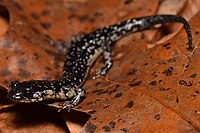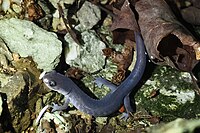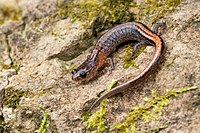| Image
|
Species and author
|
Common name
|
Geographic range
|
NatureServe status
|
IUCN status
|
|
|
P. ainsworthi
Lazell, 1998
|
Ainsworth's salamander
|
Central Mississippi? (uncertain validity)[16]
|
Possibly Extinct (GH)
|

|

|
P. albagula
Grobman, 1944
|
Western slimy salamander
|
South-central United States (Missouri southwest to central Texas)
|
Secure (G5)
|

|

|
P. amplus
Highton & Peabody, 2000
|
Blue Ridge gray-cheeked salamander
|
Southern Blue Ridge Mountains (southwest North Carolina)
|
Imperiled (G2)
|

|

|
P. angusticlavius
Grobman, 1944
|
Ozark zigzag salamander
|
Ozark Mountains (Missouri, Arkansas, and Oklahoma)
|
Apparently Secure (G4)
|

|

|
P. asupak
Mead, Clayton, Nauman, Olson & Pfrender, 2005
|
Scott Bar salamander
|
Scott Bar Mountains (Siskiyou County, northern California)
|
Imperiled (G2)
|

|
|
|
P. aureolus
Highton, 1984
|
Tellico salamander
|
Unicoi Mountains (Tennessee-North Carolina border)
|
Imperiled (G2)
|

|

|
P. caddoensis
C. Pope & S. Pope, 1951
|
Caddo Mountain salamander
|
Caddo Mountains (western Arkansas)
|
Imperiled (G2)
|

|

|
P. chattahoochee
Highton, 1989
|
Chattahoochee slimy salamander
|
Chattahoochee National Forest (northern Georgia)
|
Vulnerable (G3)
|

|

|
P. cheoah
Highton & Peabody, 2000
|
Cheoah Bald salamander
|
Cheoah Bald (Graham and Swain counties, southwest North Carolina)
|
Critically Imperiled (G1)
|

|

|
P. chlorobryonis
Mittleman, 1951
|
Atlantic Coast slimy salamander
|
Atlantic Coastal Plain (Virginia south to Georgia)
|
Secure (G5)
|

|

|
P. cinereus
(J. Green, 1818)
|
Red-backed salamander
|
Northeast North America (Nova Scotia west to Minnesota and south to North Carolina)
|
Secure (G5)
|

|

|
P. cylindraceus
(Harlan, 1825)
|
White-spotted slimy salamander
|
Southeastern United States (Virginia west to easternmost Tennessee and south to South Carolina)
|
Secure (G5)
|

|
|
|
P. dixi
C. Pope & J. Fowler, 1949
|
Dixie Cavern salamander
|
Roanoke County, southwest Virginia
|
Critically Imperiled (G1)
|

|

|
P. dorsalis
Cope, 1889
|
Northern zigzag salamander
|
South-central United States (Indiana south to Alabama)
|
Secure (G5)
|

|

|
P. dunni
Bishop, 1934
|
Dunn's salamander
|
Pacific Coast (northwest California north to southwest Washington)
|
Apparently Secure (G4)
|

|

|
P. electromorphus
Highton, 1999
|
Northern ravine salamander
|
Midwestern United States (western Pennsylvania south to central West Virginia and west to Indiana)
|
Secure (G5)
|

|

|
P. elongatus
Van Denburgh, 1916
|
Del Norte salamander
|
Pacific Coast (northwest California and southwest Oregon)
|
Apparently Secure (G4)
|

|

|
P. fourchensis
Duncan & Highton, 1959
|
Fourche Mountain salamander
|
Fourche Mountain (Scott and Polk counties, western Arkansas)
|
Imperiled (G2)
|

|

|
P. glutinosus
(J. Green, 1818)
|
Northern slimy salamander
|
Eastern United States (Connecticut south to Georgia and west to Illinois and Alabama). Range extends to Florida, Mississippi, and Louisiana according to some conceptions of the species.[14][15]
|
Secure (G5)
|

|

|
P. grobmani
Allen & Neill, 1949
|
Southeastern slimy salamander
|
Southeastern United States (Georgia, Alabama, northern Florida)
|
Secure (G5)
|
|

|
P. hoffmani
Highton, 1972
|
Valley and ridge salamander
|
Appalachian Mountains (central Pennsylvania south to southwest Virginia)
|
Secure (G5)
|

|

|
P. hubrichti
Thurow, 1957
|
Peaks of Otter salamander
|
Peaks of Otter area (southwest Virginia)
|
Imperiled (G2)
|

|
|
|
P. idahoensis
Slater & Slipp, 1940
|
Coeur d'Alene salamander
|
Rocky Mountains (northern Idaho and surrounding areas of Montana and British Columbia)
|
Apparently Secure (G4)
|

|
|
|
P. jacksoni
Newman, 1954
|
Blacksburg salamander
|
Southwest Virginia and surrounding areas of North Carolina
|
Unranked (GNR)
|

|

|
P. jordani
Blatchley, 1901
|
Red-cheeked salamander or Jordan's salamander
|
Great Smoky Mountains (Tennessee-North Carolina border)
|
Apparently Secure (G4)
|

|

|
P. kentucki
Mittleman, 1951
|
Cumberland Plateau salamander
|
Cumberland Plateau area (West Virginia south to northeast Tennessee)
|
Apparently Secure (G4)
|

|

|
P. kiamichi
Highton, 1989
|
Kiamichi slimy salamander
|
Kiamichi Mountains (Oklahoma, Arkansas)
|
Imperiled (G2)
|

|

|
P. kisatchie
Highton, 1989
|
Louisiana slimy salamander
|
Northern Louisiana and southern Arkansas
|
Vulnerable (G3)
|

|

|
P. larselli
Burns, 1954
|
Larch Mountain salamander
|
Cascade Range (northern Oregon and southern Washington)
|
Imperiled (G2)
|

|

|
P. meridianus
Highton & Peabody, 2000
|
South Mountain gray-cheeked salamander
|
South Mountains area (southwest North Carolina)
|
Imperiled (G2)
|

|

|
P. metcalfi
Brimley, 1912
|
Southern gray-cheeked salamander
|
Southern Blue Ridge Mountains (southwest North Carolina and surrounding areas of South Carolina and Georgia)
|
Apparently Secure (G4)
|

|

|
P. mississippi
Highton, 1989
|
Mississippi slimy salamander
|
South-central United States (eastern Kentucky south to Alabama and west to Louisiana)
|
Secure (G5)
|
|

|
P. montanus
Highton & Peabody, 2000
|
Northern gray-cheeked salamander
|
Appalachian and Blue Ridge mountains (southwest Virginia south to the Tennessee-North Carolina border)
|
Apparently Secure (G4)
|

|
|
|
P. neomexicanus
Stebbins & Riemer, 1950
|
Jemez Mountains salamander
|
Jemez Mountains (north-central New Mexico)
|
Critically Imperiled (G1)
|

|

|
P. nettingi
N.B. Green, 1938
|
Cheat Mountain salamander
|
Allegheny Mountains (northeast West Virginia)
|
Critically Imperiled (G1)
|

|
|
|
P. ocmulgee
Highton, 1989
|
Ocmulgee slimy salamander
|
Central Georgia
|
Unranked (GNR)
|

|

|
P. ouachitae
Dunn & Heinze, 1933
|
Rich Mountain salamander
|
Ouachita Mountains (western Arkansas and eastern Oklahoma)
|
Vulnerable (G3)
|

|
|
|
P. pauleyi
Felix, Wooten, Pierson & Camp, 2019
|
Yellow-spotted woodland salamander
|
Cumberland Plateau (southern West Virginia southwest to northeast Tennessee)
|
Unranked (GNR)
|

|

|
P. petraeus
Wynn, Highton & Jacobs, 1988
|
Pigeon Mountain salamander
|
Pigeon Mountain (northwest Georgia)
|
Imperiled (G2)
|

|

|
P. punctatus
Highton, 1972
|
Cow Knob salamander
|
George Washington National Forest (West Virginia-Virginia border)
|
Vulnerable (G3)
|

|

|
P. richmondi
Netting & Mittleman, 1938
|
Ravine salamander
|
East-central United States (southwest Virginia west to Kentucky and Indiana and south to North Carolina)
|
Secure (G5)
|

|
|
|
P. savannah
Highton, 1989
|
Savannah slimy salamander
|
East-central Georgia
|
Imperiled (G2)
|

|

|
P. sequoyah
Highton, 1989
|
Sequoyah slimy salamander
|
Beavers Bend State Park (eastern Oklahoma)
|
Critically Imperiled (G1)
|

|

|
P. serratus
Grobman, 1944
|
Southern red-backed salamander
|
Southeastern United States (southwest North Carolina west to Missouri and Oklahoma and south to Louisiana)
|
Secure (G5)
|

|

|
P. shenandoah
Highton & Worthington, 1967
|
Shenandoah salamander
|
Shenandoah National Park (Page and Madison counties, northwestern Virginia)
|
Critically Imperiled (G1)
|

|

|
P. sherando
Highton, 2004
|
Big Levels salamander
|
Big Levels (Augusta County, northwestern Virginia)
|
Imperiled (G2)
|

|

|
P. shermani
Stejneger, 1906
|
Red-legged salamander
|
Unicoi and Nantahala mountains (southwest North Carolina and surrounding areas of Tennessee and Georgia)
|
Vulnerable (G3)
|

|

|
P. stormi
Highton & Brame, 1965
|
Siskiyou Mountains salamander
|
Siskiyou Mountains (northern California and surrounding areas of Oregon)
|
Vulnerable (G3)
|

|

|
P. teyahalee
Hairston, 1950
|
Southern Appalachian salamander
|
Southern Blue Ridge Mountains (southwest North Carolina and surrounding areas of Tennessee, South Carolina, and Georgia)
|
Apparently Secure (G4)
|

|

|
P. vandykei
Van Denburgh, 1906
|
Van Dyke's salamander
|
Western Washington
|
Imperiled (G2)
|

|

|
P. variolatus
(Gilliams, 1818)
|
South Carolina slimy salamander
|
Atlantic Coastal Plain (South Carolina and Georgia)
|
Unranked (GNR)
|

|

|
P. vehiculum
(Cooper, 1860)
|
Western redback salamander
|
Pacific Coast (Oregon north to British Columbia)
|
Secure (G5)
|

|

|
P. ventralis
Highton, 1997
|
Southern zigzag salamander
|
Southeastern United States (southwest Virginia southwest to Mississippi)
|
Apparently Secure (G4)
|

|
|
|
P. virginia
Highton, 1999
|
Shenandoah Mountain salamander
|
George Washington National Forest (West Virginia-Virginia border)
|
Imperiled (G2)
|

|

|
P. websteri
Highton, 1979
|
Webster's salamander
|
Southeastern United States (South Carolina west to Mississippi)
|
Vulnerable (G3)
|

|

|
P. wehrlei
H. Fowler & Dunn, 1917
|
Wehrle's salamander
|
Appalachian Mountains (western New York south to West Virginia and western Virginia)
|
Apparently Secure (G4)
|

|

|
P. welleri
Walker, 1931
|
Weller's salamander
|
Blue Ridge Mountains (southwest Virginia south to the Tennessee-North Carolina border)
|
Vulnerable (G3)
|

|

|
P. yonahlossee
Dunn, 1917
|
Yonahlossee salamander
|
Blue Ridge Mountains (southwest Virginia south to the Tennessee-North Carolina border)
|
Apparently Secure (G4)
|

|